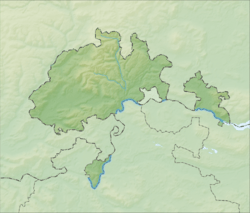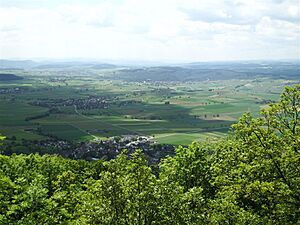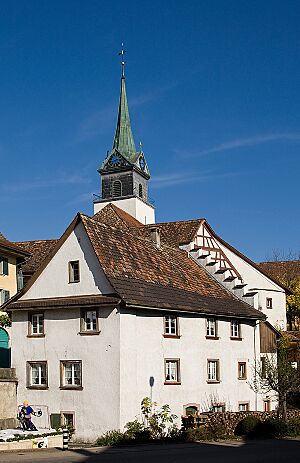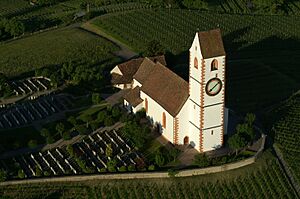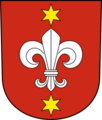Hallau facts for kids
Quick facts for kids
Hallau
|
||
|---|---|---|
 |
||
|
||
| Country | Switzerland | |
| Canton | Schaffhausen | |
| District | n.a. | |
| Area | ||
| • Total | 15.32 km2 (5.92 sq mi) | |
| Elevation | 421 m (1,381 ft) | |
| Population
(Dec 2020 )
|
||
| • Total | 2,180 | |
| • Density | 142.3/km2 (368.5/sq mi) | |
| Postal code |
8215
|
|
| Surrounded by | Eggingen (DE-BW), Neunkirch, Oberhallau, Stühlingen (DE-BW), Trasadingen, Wilchingen | |
| Twin towns | Bergün (Switzerland) | |
Hallau is a town, also called a municipality, in the canton of Schaffhausen in Switzerland. It's a lovely place known for its history and winemaking.
Contents
Hallau's Past: A Journey Through Time
Even though old Bronze Age weapons have been found here, the first signs of people living in Hallau are from the Roman times. A Roman storage building and many Roman coins were discovered. Later, a group of people called the Alamanni settled in the area. You can still find an Alamanni graveyard near the Church of St. Moritz, along with the remains of an old Alamanni village called Atlingen.
Hallau was first mentioned in old writings in 1095. Back then, it was called Hallaugia superiori et inferiori. In 1273, it was known as Hallowe. For a long time, until 1526, Hallau was part of a nearby place called Oberhallau.
Who Owned the Land?
A long time ago, about two-thirds of the land in Hallau belonged to a Benedictine monastery (a place where monks live) called All Saints in Schaffhausen. In tax records from 1100, there's no mention of vineyards (places where grapes are grown for wine). But by 1280, local vineyards started to appear in official documents.
In 1302, the Bishop of Konstanz gained special rights over both villages. These rights were called vogtei rights, which meant he had power over the area. In 1343, the villagers of Hallau worked together to get rights for a market, a mill, and taxes on salt. This helped them become more independent.
Later, in the 1400s and 1500s, the villages grew bigger. They bought more land and even a weir (a small dam) and a water mill in 1507.
Hallau's Location and Landscape
Hallau covers an area of about 15.3 square kilometers (about 5.9 square miles). A big part of this land, about 50.5%, is used for farming. Another large part, 40.3%, is covered by forests. The rest of the land has buildings, roads, or is made up of rivers and lakes.
The town is located in the Unterklettgau area. It used to be an old market town where people traded goods. Now, it's mostly known as a winemaking village. Hallau sits at the bottom of a hill called Hallauerberg. Until 1934, the town was actually called Unterhallau.
Hallau's Weather
Hallau has a mild climate, meaning it doesn't get too hot or too cold. It usually has about 118 days of rain or snow each year. On average, it gets about 806 millimeters (around 31.7 inches) of rain. The amount of rain is a bit lower here compared to other places in northern Switzerland. This is because the Klettgau region is in a "rain shadow" caused by the Black Forest mountains, which block some of the rain.
| Climate data for Hallau (1991–2020) | |||||||||||||
|---|---|---|---|---|---|---|---|---|---|---|---|---|---|
| Month | Jan | Feb | Mar | Apr | May | Jun | Jul | Aug | Sep | Oct | Nov | Dec | Year |
| Mean daily maximum °C (°F) | 3.1 (37.6) |
5.3 (41.5) |
10.5 (50.9) |
15.1 (59.2) |
19.1 (66.4) |
22.7 (72.9) |
24.9 (76.8) |
24.5 (76.1) |
19.8 (67.6) |
14.1 (57.4) |
7.5 (45.5) |
3.6 (38.5) |
14.2 (57.6) |
| Daily mean °C (°F) | 0.2 (32.4) |
1.0 (33.8) |
5.2 (41.4) |
9.1 (48.4) |
13.4 (56.1) |
17.0 (62.6) |
18.8 (65.8) |
18.4 (65.1) |
14.0 (57.2) |
9.4 (48.9) |
4.2 (39.6) |
0.9 (33.6) |
9.3 (48.7) |
| Mean daily minimum °C (°F) | −2.7 (27.1) |
−2.8 (27.0) |
0.2 (32.4) |
3.2 (37.8) |
7.4 (45.3) |
11.0 (51.8) |
12.6 (54.7) |
12.6 (54.7) |
8.7 (47.7) |
5.2 (41.4) |
1.1 (34.0) |
−1.8 (28.8) |
4.6 (40.3) |
| Average precipitation mm (inches) | 72 (2.8) |
56 (2.2) |
55 (2.2) |
57 (2.2) |
77 (3.0) |
76 (3.0) |
79 (3.1) |
71 (2.8) |
53 (2.1) |
65 (2.6) |
63 (2.5) |
82 (3.2) |
806 (31.7) |
| Average snowfall cm (inches) | 9 (3.5) |
10 (3.9) |
6 (2.4) |
0 (0) |
0 (0) |
0 (0) |
0 (0) |
0 (0) |
0 (0) |
0 (0) |
4 (1.6) |
12 (4.7) |
41 (16) |
| Average precipitation days (≥ 1.0 mm) | 10.0 | 8.7 | 9.3 | 8.8 | 10.4 | 10.4 | 11.0 | 10.3 | 8.1 | 10.3 | 9.9 | 11.4 | 118.6 |
| Average snowy days (≥ 1.0 cm) | 4.0 | 3.5 | 1.9 | 0.3 | 0.0 | 0.0 | 0.0 | 0.0 | 0.0 | 0.1 | 1.2 | 3.5 | 14.5 |
| Average relative humidity (%) | 86 | 81 | 74 | 70 | 71 | 71 | 70 | 72 | 78 | 84 | 88 | 88 | 78 |
| Source: MeteoSwiss | |||||||||||||
People of Hallau: Demographics and Education
In 2008, Hallau had a population of 2,014 people. About 15% of these residents were from other countries. Many of these foreign residents came from Germany, Italy, Serbia, and Macedonia. Over the last 10 years, the number of people living in Hallau has slightly decreased.
Most people in Hallau speak German, which is the main language. Albanian is the second most common language, followed by Italian.
Age and Education
Looking at the age groups in Hallau (in 2008):
- Children and teenagers (0–19 years old) make up about 21.9% of the population.
- Adults (20–64 years old) make up the largest group at 58.8%.
- Seniors (over 64 years old) make up 19.3%.
Switzerland is known for its good education system. In Hallau, about 81% of adults (aged 25–64) have finished high school or gone on to higher education, like a university or a special college. In 2007, some children attended kindergarten or pre-school, while others went to Primary School and Secondary School.
Religion and History
In 2000, about 14.3% of the people in Hallau belonged to the Roman Catholic Church. A larger group, 67.9%, belonged to the Swiss Reformed Church, which is a Protestant church.
Here's how Hallau's population has changed over the years:
| year | population |
|---|---|
| 1531 | 120 |
| 1771 | 1,729 |
| 1850 | 2,607 |
| 1900 | 1,870 |
| 1910 | 1,764 |
| 1950 | 1,959 |
| 2000 | 2,008 |
Important Historical Sites
The Bergkirche St. Moritz, which means "Mountain Church of St. Moritz," is a very important historical building in Switzerland. It was built in 1491. This church was a special place for pilgrims (people who travel for religious reasons) until the Protestant Reformation (a big change in Christianity) happened. This was because many old Alamanni graves and artifacts were found there.
In the early 1500s, the Church of St. Moritz became the main church for the Hallau area, separate from the church in Neunkirch.
Also, the entire village of Gächlingen, which is nearby, is recognized as an important Swiss heritage site.
Hallau's Coat of Arms
The blazon (description) of Hallau's municipal coat of arms is: Gules a Fleur de lis Argent between two Mullets Or in pale. This means it has a red background with a silver lily flower in the middle, and two gold stars placed one above the other.
Hallau's Economy: How People Work
Hallau has a low unemployment rate, which means most people who want to work can find jobs. In 2005, many people worked in different areas:
- Primary sector: About 240 people worked in farming and related businesses.
- Secondary sector: About 277 people worked in manufacturing and construction.
- Tertiary sector: About 286 people worked in services, like shops, restaurants, and offices.
In 2008, the unemployment rate was about 1.1%. Many people in Hallau work full-time, but a good number also work part-time. There were 615 residents who had jobs, and almost half of them were women. Some people who live in Hallau work in the town, while others travel to nearby places for their jobs. Also, some people travel into Hallau to work there.
Hallau also has a small tourism industry. In 2008, there were 5 restaurants and 1 hotel with 14 beds, employing 14 people.
Border Crossings
Hallau is close to the border with Germany. There are places where you can cross into Germany, specifically between Hallau town and Eberfingen, and between the village of Wunderklingen and Eggingen. Both of these German towns are in the Waldshut district in the Baden-Württemberg state.
Images for kids
as of 2006[update] as of 2008[update] as of 2000[update] as of 2007[update]
See also
 In Spanish: Hallau para niños
In Spanish: Hallau para niños




